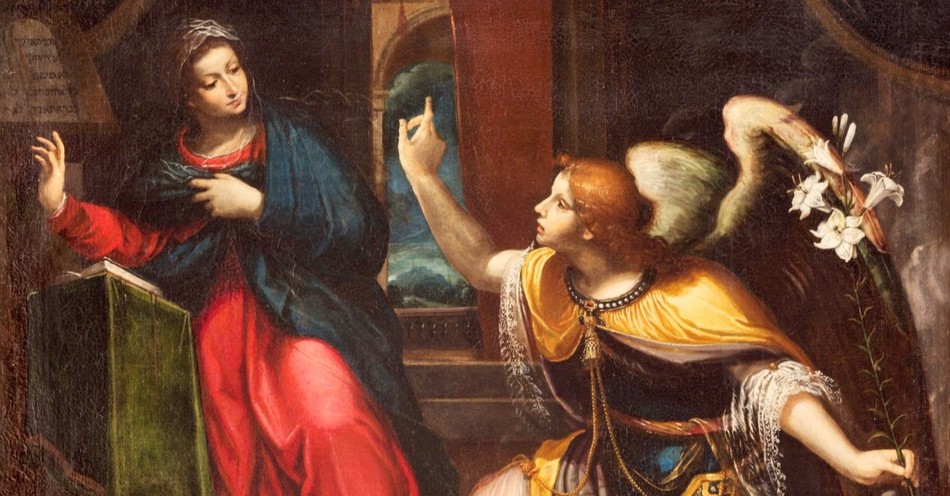The Bible passage “. . . and Mary kept all of these things in her heart” (Luke 2:19) has always been one of my favorites. It expresses Mary’s many emotions as she accepts the responsibility of being the Son of God’s mother. It must have seemed overwhelming for young, simple, and engaged but not married Mary. Mary had never had sexual relations with her fiancée, Joseph—or any other man. So, when the angel Gabriel told her that she would soon be pregnant with the Messiah, her first question was, “How can this be?”
Gabriel replied, “Nothing is impossible with God” (Luke 1:28-38). Mary listened to the rest of Gabriel’s message about the important role of raising Jesus.
The angel Gabriel tells Mary that God has found her “highly favored” (Luke 1:28), and she will bear His son, conceived by the Holy Spirit. Her child Jesus will be the Savior of the world, long anticipated by the Hebrew people. Mary embraces God’s unexpected plan for her life and responds to the angel Gabriel with the iconic words recorded in the King James Version of the Bible: “Behold the handmaid of the Lord; be it unto me according to thy word” (Luke 1:38). This passage is what is often referred to as the Annunciation.
Where Does Mary Go After the Angel Leaves?
Mary leaves Nazareth immediately after the angel’s announcement and goes “into the hill country ... into a city of Judah” to attend to her relative Elizabeth (Luke 1:36, 39). Elizabeth is an older woman and people assumed she was barren. However, by a miracle, Elizabeth is six months pregnant. She and her husband Zacharias are expecting a son—who will grow up to be John the Baptist, Jesus’ cousin who will prepare the way for His ministry. The two women spend time together, excited to become mothers and part of God’s plan to redeem the world.
Grateful for Elizabeth’s support, Mary bursts into a song (later titled the Magnificat). Here are some of her song’s lyrics.
And Mary said, My soul doth magnify the Lord,
And my spirit hath rejoiced in God my Savior.
For he hath regarded the low estate of his handmaiden: for, behold, from henceforth all generations shall call me blessed.
For he that is mighty hath done to me great things; and holy is his name. (Luke 1:46-49)
Learning you are having a baby is wonderful news for most women, and the news her baby will be the Son of God brings over-the-top joy to Mary. In the third line of The Magnificat, she acknowledges that though she is from a “low estate,” she will always be blessed by being known as Jesus’ mother.
The Magnificat also contains a prophecy for a New World Order over which Mary’s Son Jesus will reign. Mary sings out, “He has brought down rulers from their thrones but has lifted up the humble. He has filled the hungry with good things but has sent the rich away empty” (Luke 52, 53). A Warner Pacific University article on the Magnificat states that “Throughout history, poor and oppressed people have identified with this song—the longest set of words spoken by a woman in the New Testament! Some countries such as India, Guatemala and Argentina have outright banned the Magnificat because God’s preferential love for the poor was too revolutionary.” The enormous impact of Jesus’ life strikes Mary even before His birth.
Where Does Mary Go When Jesus is Born?
Young and energetic Mary travels again when she is nine months pregnant. She and her fiancé Joseph go to Jerusalem “to be enrolled in the house of David” (Luke 2:4-7), registering for the Roman census. The journey from Nazareth to Bethlehem is 90 miles. Bible scholars believe it took Mary and Joseph four days on foot with a donkey with a donkey. Riding a donkey while full-term pregnant couldn’t have been easy. Still, the young mother-to-be and trustworthy Joseph obediently made the trip to Bethlehem to follow government regulations.
The gospel authors do not express Mary’s discomfort or nervous anticipation in their “no room at the inn” birthing place. I can smell the hay and see and smell large farm animals chewing. I can see newborn Jesus lying in a livestock food trough. The manger scene appears cozy in nativity scenes and Christmas carols. The reality is childbirth is difficult and the last place you want your new baby is outdoors in a stable for livestock. Mary endured these challenges with a saintly grace. God had chosen the right young woman to bear His Son.
When Does Mary Realize Jesus is Fulfilling the Prophecies about Him?
Mary has an unusual experience in the Temple when she and Joseph observe the Jewish ritual of the Presentation, 40 days after Jesus’ birth. (The Jewish law in Leviticus 12 and Exodus 13:12-15 states that a firstborn son must be presented in the Temple in Jerusalem as an offering to God.) Simeon, an elderly and well-respected wise man who frequented the Temple, recognizes that Jesus is the Christ promised to the Hebrew people. There is joy and sadness in Simeon’s welcome, for Simeon tells Mary that one day her baby boy will break her heart like a sword plunged into her body (Luke 2:22-35). Artistic depictions of Mary with swords represent Simeon’s dire prophecy. Mary sees the angel Gabriel’s prediction and her own prophecy for her Son’s life unfolding.
When Jesus is twelve, Mary and Joseph notice he is missing from their group of relatives returning from a Passover trip to the Temple in Jerusalem. Frantic, they discover Jesus back at the Temple, discussing spiritual matters with Jewish teachers. Jesus says he is “about his Father’s business.” Mary begins to understand Jesus is fulfilling God’s purpose for His life. She must have faith to allow Jesus to separate from their ordinary family (Luke 2:49). From that time forward, “His mother kept all these things in her heart. And Jesus increased in wisdom and stature, and in favor with God and men” (Luke 2:51-52). Mary’s faith and mothering skills increase as Jesus matures.
How Does Mary Remain Faithful to the End of Jesus’ Earthly Life?
No one suffers quite like a mother who watches her child endure pain and agony, whether the child is nine or 59. Mary watches Jesus’ ministry trouble Roman authorities more and more as she travels alongside Jesus with the other disciples. She is present at the bitter end of Jesus’ life, when her Son is tried as a criminal and dies on the cross before rising to glory. Mary’s devotion shows a mother’s love for her Son and Mary’s obedience to God.
The last motherly moment a Gospel reader has of Mary is recorded in John 19:25-27, when Jesus called out from the cross to the disciple he loved, “Behold, there is your mother.” Here, Jesus refers to Mary and arranges for the disciple John to care for his mother. Joseph is now out of the picture (apparently deceased). A widow without a designated son to care for her would have a tough time surviving in first-century Judah.
The tie between a mother and son remains part of the DNA of every mother. The English Standard Version reads, “But Mary treasured up all these things, pondering them in her heart” (Luke 2:19). Her thoughts regarding Jesus’ life and mission were dear and private. She was devoted to God and Jesus from the time the angel announced her future role as the mother of God to the end of Jesus’ earthly life. These worries and hopes for her child were a huge blessing to her. Her example of motherhood blesses all women wondering how a pregnancy or childhood will result. What will the child become? Will I meet the challenges of motherhood? Will I be able to let go of my child when necessary? Parenthood requires great faith, and Mary set a wonderful example of living her faith. God used her as he uses us—in the struggle and the great joy of raising children—so that we too might fulfill His purpose on earth.
As Elizabeth said, “Blessed is she who has believed that the Lord would fulfill His promises to her!” (Luke 1:45).
Photo Credit: © Getty Images/sedmak

This article is part of our larger Christmas and Advent resource library centered around the events leading up to the birth of Jesus Christ. We hope these articles help you understand the meaning and story behind important Christian holidays and dates and encourage you as you take time to reflect on all that God has done for us through His Son, Jesus Christ!
What Is Advent: Meaning, History, and Traditions
Advent Prayers for Friends, Family, and More
What Is an Advent Wreath and How to Use One?
The History of Santa Claus: Origin of St. Nicholas
Christmas Bible Verses & Scripture Story
What is Christmas? True Meaning and Holiday History
Christmas Eve History and Traditions
Why Gold, Frankincense, and Myrrh?
When Was Jesus Born? Why December 25th
Where Was Jesus Born?

_639003522088907085.jpg)

